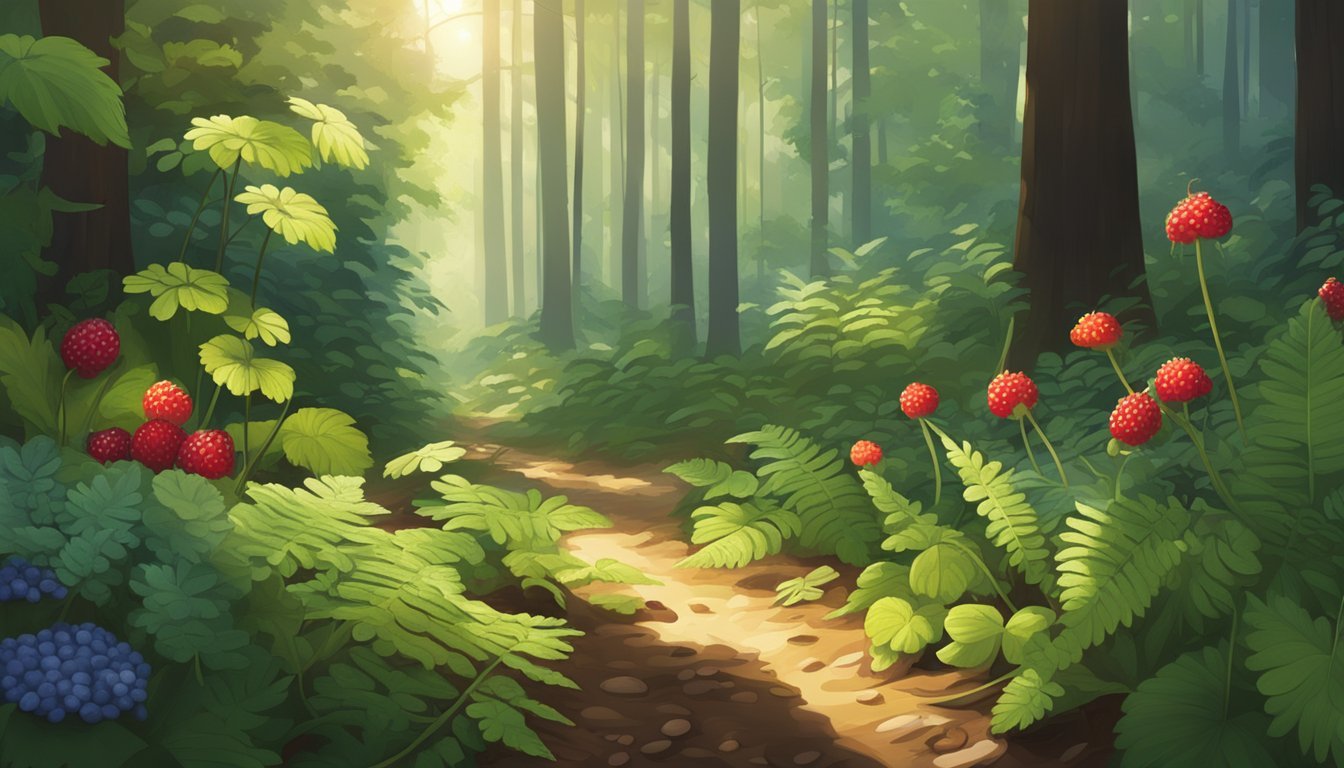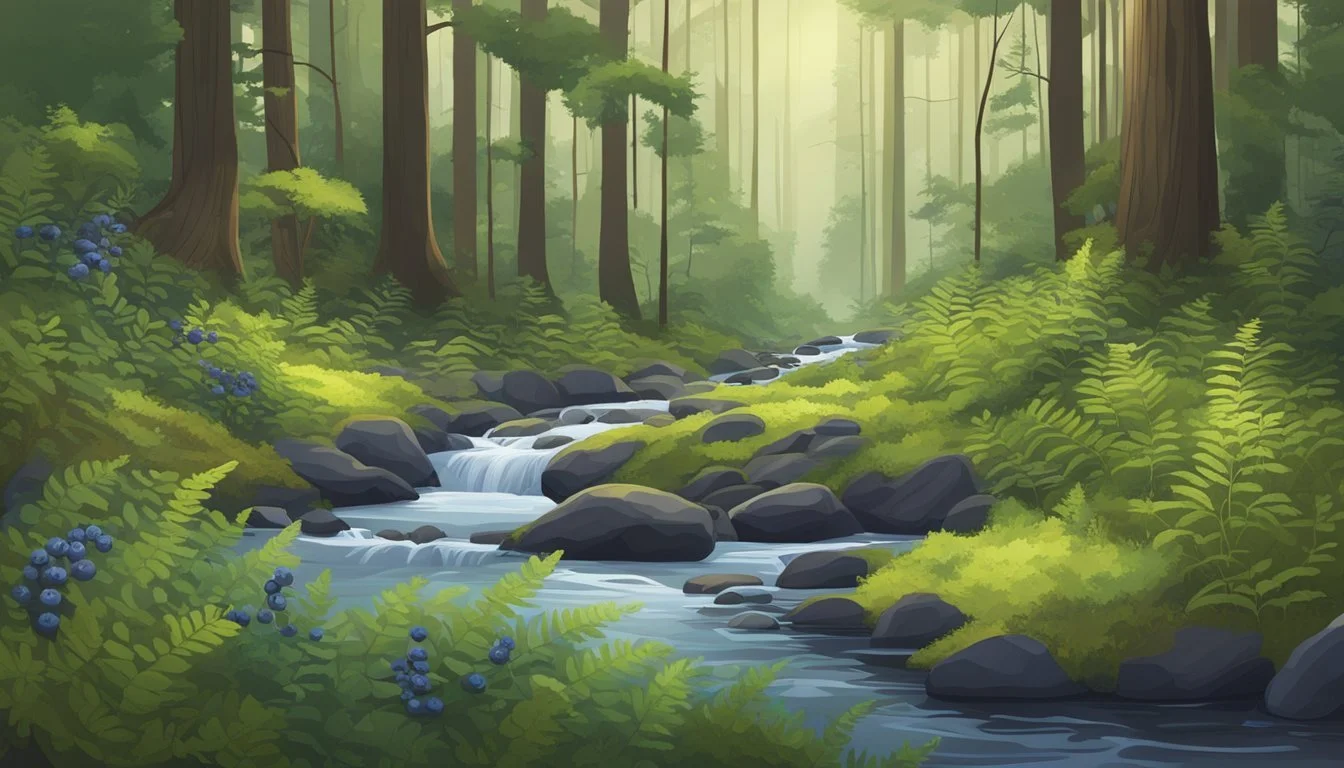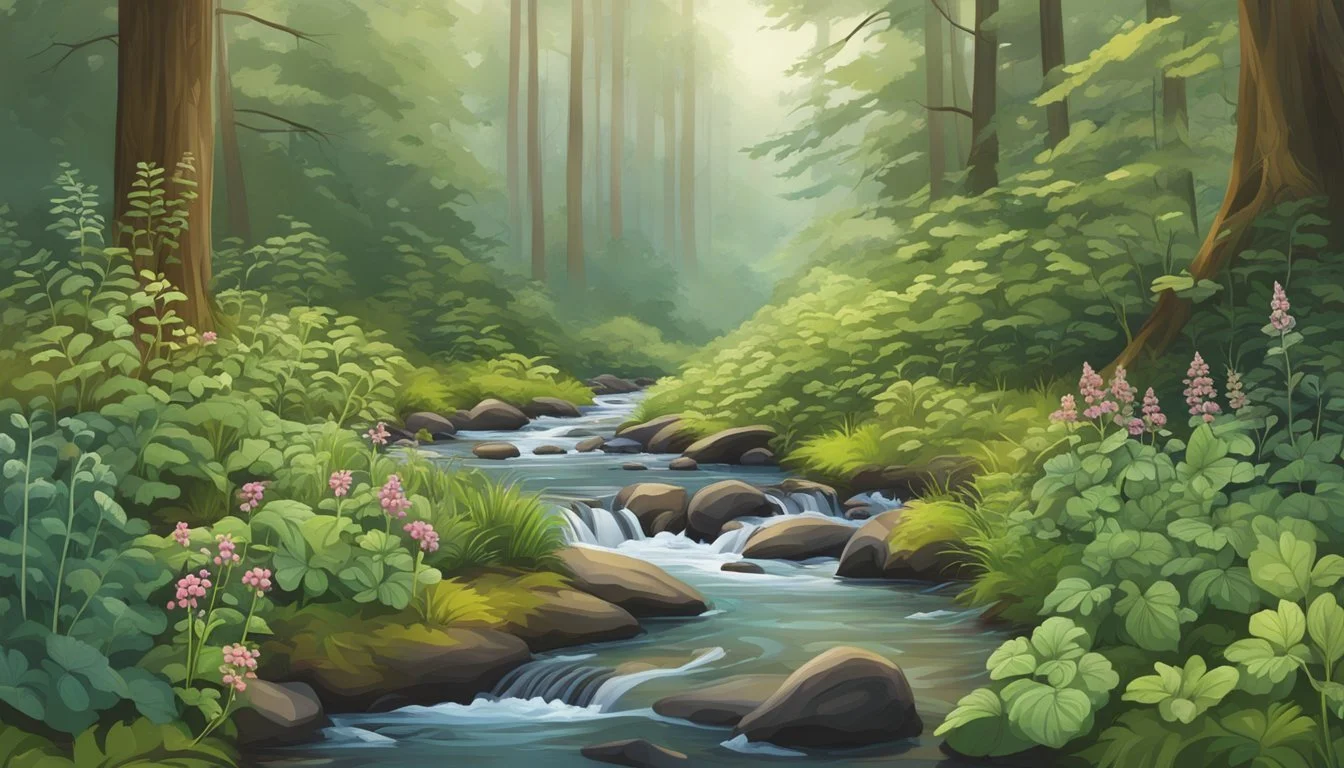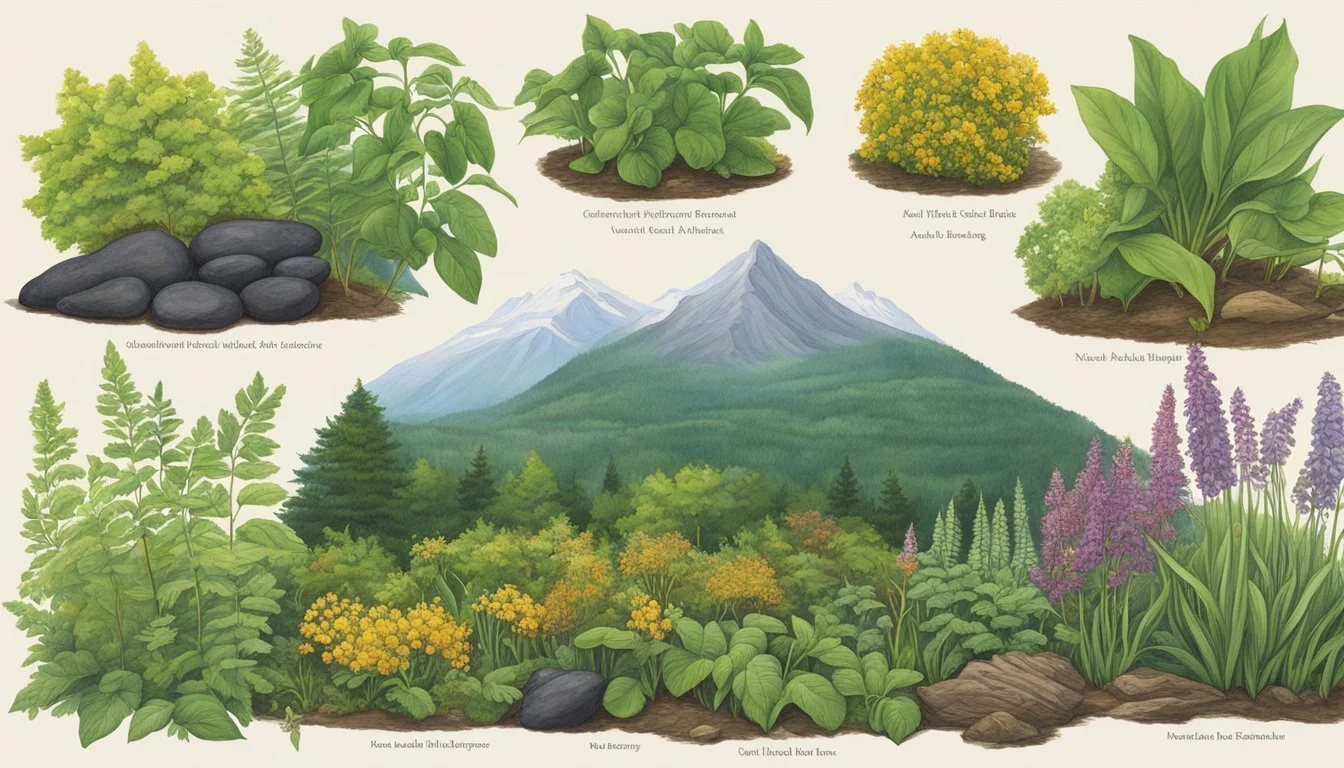Native Edible Plants in New Hampshire
A Guide to Foraging Local Flora
This Article is Part of Foraging Guide for All 50 US States
New Hampshire's diverse ecosystems harbor a rich variety of native edible plants, providing a natural pantry for those interested in foraging. The state's changing seasons and varied terrain, from the coastal plains to the high peaks of the White Mountains, create habitats for numerous plant species. Foraging, the practice of searching for and harvesting wild food resources, is a tradition that connects people with their environment and can offer a deeper appreciation for the local flora.
Among the state's native edible plants are wild berries, leafy greens, roots, and nuts (how long do nuts last?) that have supported both indigenous populations and settlers for centuries. These plants not only present an opportunity for nutritional sustenance but are also deeply intertwined with the state's cultural heritage. Responsible foraging, which entails proper identification and sustainable harvesting techniques, ensures that these plant populations remain intact for wildlife and future generations.
Interested in Mushroom Hunting in New Hampshire?
New Hampshire's lush forests and mountainous terrain offer prime habitats for a variety of edible mushrooms (What wine goes well with mushrooms?). From the White Mountains to the Great North Woods, the state boasts species like chanterelles, black trumpets, and hen of the woods. With proper identification skills and respect for regulations, foraging in New Hampshire promises a rewarding adventure.
👉 Guide on Mushroom Hunting in New Hampshire
Understanding Local Ecosystems
In New Hampshire, the variety of native edible plants is deeply connected to the local ecosystems, which are influenced by the climate, the diversity of habitats, and their importance to wildlife.
Climate and Seasonality
New Hampshire's climate significantly impacts the growth and availability of edible plants. Characterized by cold, snowy winters and warm, humid summers, the state has a distinct seasonality that dictates the lifecycles of native flora. The southern regions experience milder conditions, while areas north of Concord can have harsher winters with heavy snow accumulation, affecting the dormancy and bloom periods of many plants.
Native Plant Habitats
The state is home to various native plant habitats, ranging from the coastal plains to the rugged White Mountains. Each of these ecosystems supports a unique assemblage of edible plants:
Wetlands: host to species like cattails and wild cranberries.
Forests: a mix of deciduous and coniferous trees with understory plants such as fiddleheads and wild blueberries.
Meadows: filled with herbs like wild mint and edible flowers.
Significance to Wildlife
Native edible plants are a cornerstone for New Hampshire's wildlife, providing essential food resources. Various birds and animals depend on these plants for nutrition and sustenance throughout the year. For instance:
Berries: consumed by a wide range of birds and small mammals.
Nuts and seeds: critical for the winter survival of species like the black bear.
The interdependence between plants and wildlife creates a dynamic and resilient ecosystem across New England.
Ethical Foraging Practices
Ethical foraging ensures the sustainability of native plant populations and compliance with local regulations. It encompasses practices that protect the environment and respect the law.
Sustainable Harvesting
Foraging for native plants and edible mushrooms should never compromise the ecosystem. Adherents should:
Identify correctly: Be absolutely certain of a plant's identity, using reliable field guides or expert consultation, to avoid harvesting toxic or endangered species.
Take sparingly: Harvest only a small percentage of available plants, typically below one-third, to allow populations to regenerate.
Use appropriate tools: Employ clean, sharp instruments to make clean cuts that minimize harm to plant systems.
Disturb minimally: When foraging for wild plants, avoid damaging surrounding vegetation or soil structure.
Legal Considerations
Strict laws regulate the foraging of native plants and mushrooms, pivotal for protecting local flora. They:
Specify permissible areas: Not all land allows foraging; always seek permission or permits where required.
Limit quantities and species: Certain plants may be protected or have restrictions on the amount one can forage.
Prohibit the use of pesticides: Collecting plants where pesticides or other harmful chemicals have been applied is not only unethical but hazardous to health.
By adhering to these practices, foragers can enjoy the bounty of New Hampshire's native plants without detrimental impacts.
Plant Identification
Identifying native edible plants in New Hampshire requires attention to detail and a systematic approach to differentiate them from inedible or poisonous counterparts. Each plant has distinctive features which, when recognized, can safely guide foragers and enthusiasts.
Fundamental Characteristics
Edible wild plants can be recognized by specific characteristics, such as leaf patterns, stem textures, flower colors, and growth habits. For instance:
Leaf patterns: Simple (single leaf) or compound (leaflets).
Stem textures: Smooth, hairy, or thorny.
Flower colors: Varies widely from species to species.
Growth habits: Upright, vine, groundcover, etc.
To identify plant species accurately, one should examine these traits thoroughly.
Use of Field Guides
Field guides are indispensable tools for plant identification. They usually offer:
Images: High-quality photos or drawings of plants.
Descriptions: Details about plant characteristics.
Habitat information: Environment in which the plant thrives.
Seasonality: Time of year when the plant is likely to be found.
When using a field guide, compare the observed plant with the images and descriptions to ensure correct identification.
Distinguishing Edible from Poisonous
While identifying edible plants, it is crucial to distinguish them from poisonous varieties. Many edible plants have toxic look-alikes. Key differentiators include:
Taste: Never taste a plant unless you are certain it's safe.
Smell: Some plants have a unique odor that can aid identification.
Location: Edible plants are often found in specific habitats, unlike their poisonous counterparts.
Careful examination and cross-referencing with reliable resources are necessary to avoid the risks associated with poisonous plants. When in doubt, it is safer to avoid consuming wild plants and mushrooms without expert guidance.
Popular Native Edible Plants
New Hampshire's landscape offers a bounty of native plants that are both edible and nutritious. This section focuses on the various native edible plants across three categories: Trees and Shrubs, Herbaceous Plants, and Fungi Varieties.
Trees and Shrubs
Blueberries: These small berries are found on shrubs often in sunny, acidic soils. They are nutrient-rich and can be eaten raw or used in a myriad of recipes.
Elderberry: Found in moist, well-drained soil, elderberry shrubs produce clusters of dark purple berries that are commonly used in syrups and jams.
Serviceberry: Also known as shadbush, this small tree or large shrub produces sweet, edible berries that resemble blueberries in shape and color.
Shagbark Hickory (Carya ovata): The nuts of this tree are edible and have a distinctive sweet taste. The bark of the tree is also distinctive, peeling off in large strips.
White Oak: Acorns from the white oak are a traditional food source, which, after leaching, can be ground into flour or roasted for a nutty flavor.
Yellow Birch: The sap of this tree can be boiled down to make birch syrup, while young twigs can be used as a spice due to their wintergreen flavor.
Herbaceous Plants
Dandelion: Every part of this ubiquitous plant is edible, from the leaves, which can be used in salads, to the roots, which can be roasted to make a coffee substitute.
Fiddleheads: The young, coiled fronds of the ostrich (What wine goes well with ostrich?) fern are harvested as fiddleheads and are considered a seasonal delicacy when cooked.
Ramps: Also known as wild leeks, these plants have a strong onion-garlic flavor and are often used in cooking, similar to leeks or scallions.
Sassafras: The roots of the sassafras plant can be used to make tea, and its leaves are sometimes used in traditional Cajun cuisine.
Blackberry: The fruits from this common shrub are frequently found in the wild and can be eaten fresh or used in pies, jams, and jellies.
Fungi Varieties
Chaga: This fungus grows on birch trees and is often harvested for its medicinal properties, which includes being used to make tea.
Chicken of the Woods: This brightly colored fungus is noted for its meaty texture and can be used as a substitute for chicken in recipes. It grows on the sides of trees, particularly oaks.
In summary, native edible plants in New Hampshire not only provide opportunities for local foraging but also contribute to a diverse and healthful diet.
Culinary Uses and Recipes
Exploring the culinary applications of New Hampshire's native plants can transform wild edibles from forest flora to tantalizing table fare.
Cooking with Native Plants
Incorporating native plants into one's kitchen endeavors provides a way to connect with regional history and sustainable food sources. The common dandelion (Taraxacum officinale), often unfairly labeled as a weed, offers both leaves and flowers that are rich in vitamins and can be used in salads or as a cooked green. Fiddlehead ferns (Matteuccia struthiopteris), harvested in spring, need to be cooked thoroughly and can impart a grassy, nutty flavor to dishes. They make a fine addition to stir-fries or pasta.
One must ensure to correctly identify and often detoxify certain wild edibles through specific preparation methods such as boiling to avoid potential toxicity. Furthermore, it's imperative to harvest responsibly to avoid depleting natural populations or disturbing ecological balances.
Wild Plant Recipes
Creating recipes with wild edibles offers unique opportunities to enjoy nature's bounty and enhance the nutritional value of meals. Below are simple recipes showcasing native edible plants of New Hampshire.
Edible Berry Tea
Ingredient Quantity Wild blackberries 1 cup Wild blueberries 1 cup Water 4 cups Honey (optional) To taste
Place the berries in a pot and crush them slightly to release their juices.
Add water and bring to a boil. Simmer for 10 minutes.
Strain to remove the berry skins and seeds.
Serve hot or chilled, sweetened with honey if desired.
Salad with Wild Greens
Ingredient Quantity Dandelion leaves 2 cups, young & tender Violets 1 cup, flowers & leaves Red clover 1/2 cup, flower heads Apple cider vinegar (how long does apple cider vinegar last?) 2 tablespoons Olive oil 4 tablespoons Salt & pepper To taste
Rinse and dry the dandelion leaves, violets, and red clover heads.
Whisk together
Health Benefits and Nutritional Value
Native edible plants and mushrooms in New Hampshire offer a spectrum of health benefits and nutritional value. They contribute to a balanced diet by providing essential vitamins and minerals while also having traditional medicinal uses.
Vitamin and Mineral Content
New Hampshire's edible plants, including berries, nuts, and leafy greens are particularly rich in Vitamin C, which is pivotal for immune system function and skin health. For example, wild strawberries and pine needle tea are excellent sources of Vitamin C. The table below highlights key plants and their nutritional properties:
Edible Plant Vitamin C Content Other Nutrients Wild Strawberries High Manganese, Fiber Pine Needles Very High Vitamin A Dandelion Greens Moderate Iron, Calcium
Edible mushrooms, although generally low in Vitamin C, support a healthy diet through their mineral content and essential B vitamins.
Medicinal Uses
Many edible plants found in New Hampshire have been used historically for medicinal purposes, and some of these uses are supported by modern research. For instance:
Dandelion greens possess diuretic properties and may support liver health.
Wild strawberries have anti-inflammatory effects and can contribute to heart health.
Edible mushrooms like the Chaga mushroom, often made into a tea, have been attributed with antioxidant and immune-supporting properties. Their use stems from a long history of medicinal applications by indigenous and local cultures.
Conservation and Cultivation
Careful consideration of propagation methods and landscape designs enhances the conservation and successful cultivation of New Hampshire's native plants. These practices support essential pollinators, maintaining ecological balance and plant diversity.
Propagation Methods
To preserve native species like the basswood, propagation techniques should align with individual species requirements. For shade-loving plants, seed stratification might be necessary, while full sun species may require scarification or direct sowing.
Seed Stratification: A process usually for species requiring a period of cold to germinate.
Cuttings: Effective for various cultivars, ensuring genetic similarity with parent plants.
Division: This can help propagate mature clumps of perennials, maintaining landscape design.
Creating a Native Plant Landscape
A native plant landscape requires understanding the specific needs of each plant. Planning should account for optimal light conditions, with certain areas of the garden dedicated to full sun or shade to match plant preferences.
Light Requirements: Assign plants like basswood to areas that align with their natural habitat, ensuring they thrive.
Soil Preparation: Amend soil in accordance with the needs of the native flora, which may differ from region to region.
Supporting Pollinators in the Garden
Native plants such as the basswood provide crucial resources for bees and other pollinators. Garden layouts should consider flowering times and plant groupings to offer a continuous food source.
Bee Attraction: Include a variety of flowering plants that bloom at different times to continuously attract bees.
Group Plantings: Clusters of the same plant species can create a more enticing and efficient feeding area for pollinators.
By incorporating these careful strategies in propagation, landscape design, and pollinator support, one can foster a thriving environment that preserves and celebrates the indigenous botanical heritage of New Hampshire.
Cultural and Historical Context
New Hampshire, often referred to as the Granite State, has a rich legacy of indigenous flora that has provided sustenance to its inhabitants for centuries. The use of wild foods is deeply rooted in the cultural fabric of the region, shaping the dietary habits of both Native American communities and early settlers.
Native American Uses
Native Americans in New Hampshire foraged for wild edibles as a substantial part of their diet, utilizing extensive knowledge about the land and seasonal cycles. They typically gathered berries, nuts, and various greens that grew in abundance across the state's diverse ecosystems. Plants like blueberries (Vaccinium corymbosum), maple trees (Acer spp.) for syrup, and wild grapes (Vitis spp.) were not only sources of nourishment but also held medicinal and ceremonial significance.
Berries: They were eaten fresh, dried, or incorporated into meals.
Nuts: Such as acorns and hickory, were ground into meals for cooking.
Greens: Including fiddleheads and wild leeks, were foraged in the springtime.
Historical Foraging Practices
During colonial times and subsequent centuries, European settlers adopted and adapted Native American foraging practices to supplement their diet. They learned to identify and harvest native plants, which added variety to their sustenance and were often more reliable than cultivated crops. Documentation from the era reveals a reliance on wild edibles—an insight into the historical diet of the Granite State.
Roots: Settlers harvested tubers and roots like Jerusalem artichokes (how long do artichokes last?) and groundnuts.
Fruits: Apples (varieties that grew wild or were minimally tended) and berries became staple food sources.
Herbs: Wild herbs for culinary and medicinal use were collected from forests and fields.
The shared knowledge between Native Americans and early settlers established a foundation for the foraging practices that echoed throughout New Hampshire's history.
Further Reading and Resources
To fully understand and utilize Native Edible Plants in New Hampshire, reference materials and community workshops are invaluable. They offer a depth of knowledge and interactive learning opportunities for enthusiasts at any level.
Additional Literature
Books:
"Edible Wild Plants: Eastern/Central North America" by Lee Allen Peterson
"The Forager's Harvest: A Guide to Identifying, Harvesting, and Preparing Edible Wild Plants" by Samuel Thayer
Reference Guides:
"A Field Guide to Edible Wild Plants: Eastern and Central North America" by Lee Allen Peterson
"Wild Berries & Fruits Field Guide of Minnesota, Wisconsin, and Michigan" by Teresa Marrone (relevant for comparative regional knowledge)
Online Communities and Workshops
Websites:
Foragers Guild: A website offering a directory of foraging workshops across New Hampshire.
Eat The Weeds: An expansive forum for discussions related to foraging and identifying edible plants.
Local Workshops:
New Hampshire Herbal Network: They host events and workshops on herbal remedies and wild edibles.
The Foraging Society: Regular meetups and educational walks focusing on plant identification and sustainable harvesting.
Utilizing these resources will provide a solid foundation and enhance practical knowledge about foraging for native edible plants.






